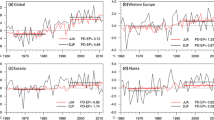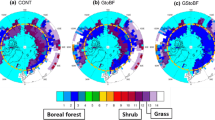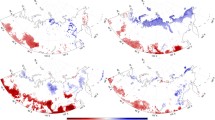Abstract
In order to test the sensitivity of regional climate to regional-scale atmosphere-land cover feedbacks, we have employed a regional climate model asynchronously coupled to an equilibrium vegetation model, focusing on the western United States as a case study. CO2-induced atmosphere-land cover feedbacks resulted in statistically significant seasonal temperature changes of up to 3.5°C, with land cover change accounting for up to 60% of the total seasonal response to elevated atmospheric CO2 levels. In many areas, such as the Great Basin, albedo acted as the primary control on changes in surface temperature. Along the central coast of California, soil moisture effects magnified the temperature response in JJA and SON, with negative surface soil moisture anomalies accompanied by negative evaporation anomalies, decreasing latent heat flux and further increasing surface temperature. Additionally, negative temperature anomalies were calculated at high elevation in California and Oregon in DJF, MAM and SON, indicating that future warming of these sensitive areas could be mitigated by changes in vegetation distribution and an associated muting of winter snow-temperature feedbacks. Precipitation anomalies were almost universally not statistically significant, and very little change in mean seasonal atmospheric circulation occurred in response to atmosphere-land cover feedbacks. Further, the mean regional temperature sensitivity to regional-scale land cover feedbacks did not exceed the large-scale sensitivity calculated elsewhere, indicating that spatial heterogeneity does not introduce non-linearities in the response of regional climate to CO2-induced atmosphere-land cover feedbacks.









Similar content being viewed by others
References
Arribas A, Gallardo C, Gaertner MA, Castro M (2003) Sensitivity of the Iberian Peninsula climate to a land degradation. Clim Dyn 20:477–489
Bakun A (1990) Global climate change and intensification of coastal ocean upwelling. Science 247:198–201
Bell JL, Sloan LC, Snyder MA (2004) Regional changes in extreme climatic events. J Clim 17:81–87
Bergengren JC, Thompson SL, Pollard D, DeConto RM (2001) Modeling global climate-vegetation interactions in a doubled CO2 world. Clim Change 50:31–75
Chen M, Pollard D, Barron EJ (2004) Regional climate change in East Asia simulated by an interactive atmosphere-soil vegetation model. J Clim 17:557–572
Claussen M (1996) Variability of global biome patterns as a function of initial and boundary conditions in a climate model. Clim Dyn V12:371–379
Cramer W, Bondeau A, Woodward F I, Prentice IC, Betts RA, Brovkin V, Cox PM, Fisher V, Foley JA, Friend AD, Kucharik C, Lomas MR, Ramankutty N, Sitch S, Smith B, White A, Young-Molling C (2001) Global response of terrestrial ecosystem structure and function to CO2 and climate change: results from six dynamic global vegetation models. Glob Change Biol 7:357–373
Dickinson RE, Henderson-Sellers A, Kennedy PJ (1993) Biosphere-Atmosphere Transfer Scheme (BATS) Version 1e as Coupled to the NCAR Community Climate Model. NCAR Technical Note NCAR/TN-387+STR. National Center for Atmospheric Research, Boulder CO, pp 72
Diffenbaugh NS, Sloan LC, Snyder MA (2003a) Orbital suppression of wind-driven upwelling in the California Current at 6 ka. Paleoceanography 18,1051, doi:1010.1029/2002000865
Diffenbaugh NS, Sloan LC, Snyder MA, Bell JL, Kaplan JO, Shafer SL, Bartlein PJ (2003b) Vegetation sensitivity to global anthropogenic carbon dioxide emissions in a topographically complex region. Global Biogeochem Cycle 17,1067, doi:1010.1029/2002GB001974
Diffenbaugh NS, Snyder MA, Sloan LC (2004) Could CO2-induced land cover feedbacks alter near-shore upwelling regimes?. Proceedings of the National Academy of Sciences 101:27–32
Douville H, Planton S, Royer JF, Stephenson DB, Tyteca S, Kergoat L, Lafont S, Betts RA (2000) Importance of vegetation feedbacks in doubled-CO2 climate experiments. J Geophys Res-Atmos 105:14841–14861
Easterling DR, Meehl GA, Parmesan C, Changnon SA, Karl TR, Mearns LO (2000) Climate extremes: Observations, modeling, and impacts. Science 289:2068–2074
FAO (1995) Digital Soil Map of the World and Derived Soil Properties CD-ROM, Food and Agriculture Organization, Rome.
Gao XJ, Zhao ZC, Ding YH, Huang RH, Giorgi F (2001) Climate change due to greenhouse effects in China as simulated by a regional climate model. Adv Atmos Sci 18:1224–1230
Giorgi F, Mearns LO (1999) Introduction to special section: Regional climate modeling revisited. J Geophys Res-Atmos 104:6335–6352
Giorgi F, Shields C (1999) Tests of precipitation parameterizations available in latest version of NCAR regional climate model (RegCM) over continental United States. J Geophys Res-Atmos 104:6353–6375
Hong SY, Kalnay E (2000) Role of sea surface temperature and soil-moisture feedback in the 1998 Oklahoma-Texas drought. Nature 408:842–844
Hopp MJ, Foley JA (2001) Global-scale relationships between climate and the dengue fever vector, Aedes aegypti. Clim Change 48:441–463
Hostetler SW, Bartlein PJ, Clark PU, Small EE, Solomon AM (2000) Simulated influences of Lake Agassiz on the climate of central North America 11,000 years ago. Nature 405:334–337
Hungate BA, Dukes JS, Shaw MR, Luo Y, Field CB (2003) Nitrogen and climate change. Science 302:1512–1513
Huxman TE, Hamerlynck EP, Moore BD, Smith SD, Jordan DN, Zitzer SF, Nowak RS, Coleman JS, Seemann JR (1998) Photosynthetic down-regulation in Larrea tridentata exposed to elevated atmospheric CO2: interaction with drought under glasshouse and field (FACE) exposure. Plant Cell Environ 21:1153–1161
Intergovernmental Panel on Climate Change W G I (2001) Climate Change 2001: The Scientific Basis. Cambridge University Press, New York.
Jackson ST, Overpeck JT (2000) Responses of plant populations and communities to environmental changes of the late Quaternary. Paleobiology 26:194–220 Supplemental S
Kaplan JO (2001) Geophysical Applications of Vegetation Modeling. Dissertation Thesis, Lund University, Lund, Sweden, pp 128
Karl TR, Trenberth KE (2003) Modern global climate change. Science 302:1719–1723
Kiehl JT, Hack JJ, Bonan GB, Boville BA, Williamson DL, Rasch PJ (1998) The National Center for Atmospheric Research Community Climate Model: CCM3. J Clim 11:1131–1149
Kuchler AW (1964) Potential natural vegetation of the coterminous United States. American Geographical Society of New York, New York
Laprise R, Caya D, Frigon A, Paquin D (2003) Current and perturbed climate as simulated by the second-generation Canadian Regional Climate Model (CRCM-II) over northwestern North America. Clim Dyn 21:405–421
Leung LR, Ghan SJ (1999) Pacific northwest climate sensitivity simulated by a regional climate model driven by a GCM. Part II: 2xCO2 simulations. J Clim 12:2031–2053
Levis S, Foley JA, Pollard D (2000) Large-scale vegetation feedbacks on a doubled CO2 climate. J Clim 13:1313–1325
Neiman PJ, Ralph FM, White AB, Kingsmill DE, Persson POG (2002) The statistical relationship between upslope flow and rainfall in California’s coastal mountains: Observations during CALJET. Mon Weather Rev 130:1468–1492
Neiman PJ, Persson POG, Ralph FM, Jorgensen DP, White AB, Kingsmill D E (2004) Modification of fronts and precipitation by coastal blocking during an intense landfalling winter storm in southern California: Observations during CALJET. Mon Weather Rev 132:242–273
de Noblet-Ducoudre N, Claussen R, Prentice C (2000) Mid-Holocene greening of the Sahara: first results of the GAIM 6000 year BP experiment with two asynchronously coupled atmosphere/biome models. Clim Dyn 16:643–659
Olson JS, Watts JA, Allison LJ (1983) Carbon in Live Vegetation of Major World Ecosystems. Oak Ridge National Laboratory, Oak Ridge TN USA
Pal JS, Eltahir EAB (2003) A feedback mechanism between soil-moisture distribution and storm tracks. Quarterly Journal of the Royal Meteorological Society 129:2279–2297
Pal JS, Small EE, Eltahir EAB (2000) Simulation of regional-scale water and energy budgets: Representation of subgrid cloud and precipitation processes within RegCM. J Geophys Res-Atmos 105:29579–29594
Pitman AJ, Zhao M (2000) The relative impact of observed change in land cover and carbon dioxide as simulated by a climate model. Geophys Res Lett 27:1267–1270
Raisanen J, Hansson U, Ullerstig A, Doscher R, Graham LP, Jones C, Meier HEM, Samuelsson P, Willen U (2004) European climate in the late twenty-first century: regional simulations with two driving global models and two forcing scenarios. Clim Dyn 22:13–31
Ramankutty N, Foley JA (1999) Estimating historical changes in global land cover: Croplands from 1700 to 1992. Global Biogeochem Cycle 13:997–1027
Root TL, Price JT, Hall KR, Schneider SH, Rosenzweig C, Pounds JA (2003) Fingerprints of global warming on wild animals and plants. Nature 421:57–60
Schoenherr AA (1992) A natural history of California. University of California Press, Berkeley CA, pp 772
Seneviratne SI, Pal JS, Eltahir EAB, Schar C (2002) Summer dryness in a warmer climate: a process study with a regional climate model. Clim Dyn 20:69–85
Snyder MA, Bell JL, Sloan LC, Duffy P, Govindasamy B (2002) Climate responses to doubling of atmospheric carbon dioxide for a climatically vulnerable region. Geophys Res Lett 29,1514, doi:10.1029/2001GL014431
Snyder MA, Sloan LC, Diffenbaugh NS, Bell JL (2003) Future climate change and upwelling in the California Current. Geophys Res Lett 30,1823, doi:10.1029/2003GL017647
Snyder MA, Sloan LC, Bell JL (2004) Modeled Regional Climate Change in the Hydrologic Regions of California: A CO2 Sensitivity Study. Journal of the American Water Resources Association 40:591–601
Walther GR, Post E, Convey P, Menzel A, Parmesan C, Beebee TJC, Fromentin JM, Hoegh-Guldberg O, Bairlein F (2002) Ecological responses to recent climate change. Nature 416:389–395
Acknowledgements
I thank L. C. Sloan for general guidance and thoughtful readings of the manuscript, M. A. Snyder and J. L. Bell for access to the G-280, G-560, Control and Iteration0 integrations and for assistance with RegCM2.5, J. O. Kaplan and S. L. Shafer for assistance with BIOME4, and P. J. Bartlein for helpful discussions of the RegCM2.5/BIOME4 coupling. I also thank four anonymous reviewers for their very thorough comments, which greatly improved the manuscript. Funding was provided by the David and Lucile Packard Foundation, the ARCS Foundation, and National Science Foundation grant ATM/ESH-0315677. This is PCCRC publication 0401.
Author information
Authors and Affiliations
Corresponding author
Rights and permissions
About this article
Cite this article
Diffenbaugh, N.S. Atmosphere-land cover feedbacks alter the response of surface temperature to CO2 forcing in the western United States. Clim Dyn 24, 237–251 (2005). https://doi.org/10.1007/s00382-004-0503-0
Received:
Accepted:
Published:
Issue Date:
DOI: https://doi.org/10.1007/s00382-004-0503-0




